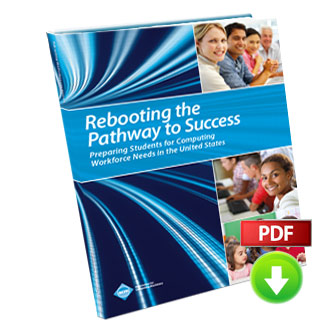The Challenge
In the United States, ACM's commitment to rigorous K-12 computer science education has involved a wide range of activities. These include: supporting the development of curricular standards at all levels; participating in the creation of a new secondary-level computer science course and new approaches to teaching it; developing new approaches to training and certifying secondary computer science teachers; creating a national community of secondary-level computer science teachers; educating policymakers on the importance of computer science; and convincing states, school districts, and individual schools to bring computer science into their curricula as a core subject.
Collectively, the above activities are aimed at shifting the U.S. education system - a monumental task. At every step of this effort, it is necessary to convince individuals in positions of influence that the need for a solid education in computer science is a national imperative. The reasons are compelling: (1) the majority of new jobs in STEM-based careers will be in computing fields or will require a deep understanding of computer science; (2) access to rigorous computer science education is an important individual right since it provides students with the problem solving and analysis skills that are invaluable to many career disciplines; (3) computer science education serves as the entry for pathways to successful, rewarding, and fulfilling computing careers; and (4) the country's future innovations and economic prosperity depend strongly on its excellence in computer science.
A crucial step in examining U.S. secondary education in computer science was the report Running on Empty: The Failure to Teach K-12 Computer Science in the Digital Age, released in 2010. Its data showed clearly that computer science curricular standards were not widely adopted, and that rigorous computer science courses rarely counted as a core mathematics or science high school graduation requirement.
This report is a successor to Running on Empty, examining the workforce demand for computing professionals and discussing successful computer science education pathways. It contains a nationwide assessment of the computing workforce landscape and the extent to which states are preparing students with fundamental computer science knowledge and skills. It demonstrates that there is a substantial computing workforce in every state, and it shows that the size of this workforce will grow significantly over the next decade. The report also demonstrates that few states are positioned to provide the computer science education required for rewarding careers and for ensuring future workforce needs are met. Finally, it shows through examples that a diverse set of states and municipalities have developed and implemented programs for teaching computer science in both academic and career technical education tracks. These programs can serve as models for policymakers and educators to consider when developing plans to expand computer science education in their own contexts.
The findings of this report are clear, and they are relevant to every country. Education in the fundamentals of computer science is key to individuals in a country having access to rewarding careers, and it is key to a country developing and sustaining a competitive 21st century workforce and succeeding in innovation.
Robert B. Schnabel
Chair, ACM Education Policy Committee
Vint Cerf
ACM President
John White
ACM Executive Director and Chief Executive Officer
The Scope
This study gathered data from all 50 states and the District of Columbia on the presence of computing jobs and what salaries those computing jobs are paying. The study also examined the extent to which students are taking the Advanced Placement (AP) Computer Science A exam in high school, and then to what extent states are awarding postsecondary computer science and other computing-related degrees. These metrics paint a picture of how well states are preparing students for computing careers.


 Download the Report in PDF (4 MB)
Download the Report in PDF (4 MB)


